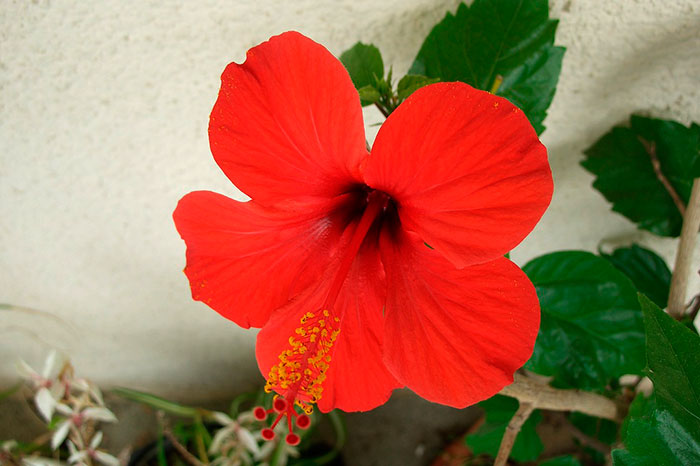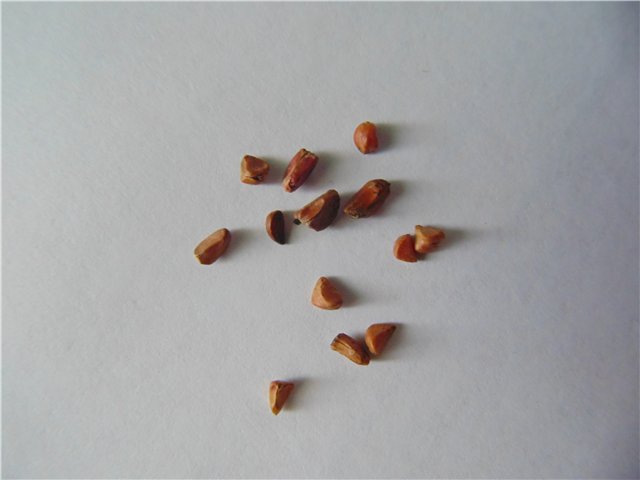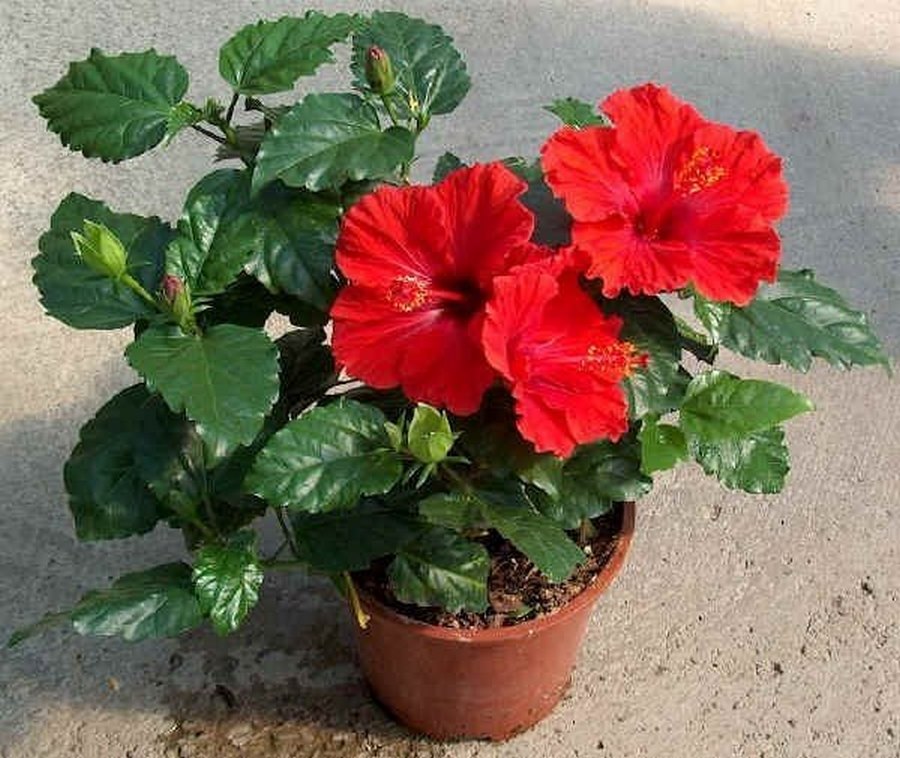Content:
The Chinese rose, or hibiscus, is a popular houseplant that blooms in many homes. Even novice growers can grow it. To propagate this flower is also not difficult.
How to grow a Chinese rose at home
The Chinese rose has large leaves and large bright flowers with long stamens. The color is usually red, but there are white, purple and other varieties. Flowers are double, semi-double and simple. Hibiscus is native to Southeast Asia. Some species are planted in the southern regions at their summer cottages. In colder climates, hibiscus does not bloom outdoors, but at home, the Chinese rose feels great.
There are many beliefs associated with the hibiscus flower. It is believed that the flowering of a Chinese rose at an uncharacteristic time for it is an unkind sign. Therefore, hibiscus is called the flower of death. But this does not mean that the plant brings trouble, it just reacts to the environment.
You should also be more careful if the flowers of the Chinese rose turn yellow and wither, as this may be a harbinger of a grower's disease. But, if you carry out the cultivation of the hibiscus flower of death according to all the rules, then it will be healthy and will not embarrass anyone with its fading appearance.
For hibiscus growing at home, procedures such as:
- watering;
- spraying;
- top dressing;
- topping;
- pruning.
Plants less than 5 years old should be replanted annually. The procedure is carried out in the spring. Watering in summer after 3 days, and a little less often in winter. The main thing is to make sure that the soil in the pot does not dry out and that a crust does not form. It is worth watering with warm, settled water at room temperature. At the bottom of the pot, drainage must be foreseen in advance to avoid root rot.
The Chinese rose needs to be shaped, otherwise it will turn into a sloppy bush. To do this, remove the top. The procedure is carried out in the spring after transplantation. Also cut by a third in the fall, and cut off by half in winter. As a rule, shoots growing parallel to the main trunk and branches that tend to the inside of the bush are removed.
The transplant is quite simple. A hibiscus with a soil ball is placed in a new earthen mixture by transferring. When the plant gets too large, instead of replanting, it will be enough to simply change the top layer in the pot.
Chinese rose: how to propagate
How does the Chinese rose reproduce? Under natural conditions, hibiscus propagates by seeds; at home, it is bred vegetatively using cuttings. Seeds can also be used, as they have good germination. In addition, young sprouts are easy to care for.
Seed propagation
Seeds remain germinating for 5 years, but before planting they need to be disinfected in a solution of potassium permanganate. Sown in the last decade of February or early March. For successful cultivation, you will need a fertile soil mixture, growth stimulants (epin, zircon) and a mini greenhouse.
Overnight, the seeds are soaked without completely covering them with water to maintain oxygen access. In the morning, they are placed in wet gauze and then in a plastic bag. Ventilation holes must be made in the bag. A mini greenhouse can be used instead of a bag. The main thing is to provide the seeds with ventilation.
The seeds will show sprouts after a few days. They are sprayed with warm water. The air temperature should be within 25 ° C. When 3 true leaves appear, the seedlings dive. The soil for the pots should consist of humus and turf in a 1: 1 ratio. Next, you need moderate watering and sufficient lighting, but not with direct rays.
A Chinese rose obtained from seeds will bloom for 3 years. Also, a transplant is required annually until the plant becomes an adult.
Vegetative way
The vegetative way of propagation of hibiscus is the most common. Breeding by cuttings is possible throughout the year, but it is preferable to do this in spring or summer. Shoots are harvested when pruning a Chinese rose.
For cuttings and cuttings, there are two ways of rooting:
- in water;
- in the soil.
Both methods are equally effective in producing healthy and robust plants. But, if the rose is cut by cuttings, then you can wait for flowering earlier. A step-by-step guide for rooting shoots in soil:
- The cups are filled with soil with the addition of peat.
- The stalk is dipped into a growth stimulator and then into the soil.
- The earth around is tamped and watered with warm water.
- The cups are placed in a greenhouse or covered with foil.
- A temperature of 25 ° C and high humidity must be maintained.
- The roots will appear after a month.
Rules for rooting hibiscus shoots in water:
- The container for the cutting should be made of dark glass.
- Be sure to warm the water and let it settle.
- Add 2 tablets of activated charcoal and growth stimulant.
- Place the container with shoots in a place with good lighting, but so that the direct rays of the sun do not fall on the plant.
- From time to time you need to check the condition of the roots and add water.
- A Chinese rose is planted in a pot of soil when the roots reach a length of 6 cm and a couple of new leaves appear.
Features of growing a Chinese rose at home in a pot
After the rooting of the Chinese rose, it is transplanted by transferring it into a pot 1 cm larger than the previous one. The soil should be fertile and easy to let air through. Drainage is done at the bottom of the pot, since the Chinese rose does not react well to stagnant moisture.
The most common mistakes novice growers make in caring for hibiscus:
- Too low air temperature or insufficient watering, and the Chinese rose begins to shed the buds that have not yet opened. It is imperative in the spring to transplant the flower into nutrient-rich soil and keep it in a warm, draft-free place.
- Very dry air causes yellowness in new leaves, and fall off in lower ones. The Chinese rose needs to be sprayed more often with a spray bottle. Similar symptoms occur with a lack of nitrogen and iron. To avoid trouble, it is best to stand for water for irrigation.
It happens that hibiscus looks normal in appearance, but does not bloom. There may be several reasons for this:
- the plant does not have enough light;
- too frequent feeding, so hibiscus forms a lot of green mass, but does not form buds;
- lack of fertilizers, in which the Chinese rose not only does not bloom, but also sheds its leaves;
- insufficient watering causes the slightly formed buds to fall off;
- the pot is too large, as the rose blooms when the root system fills the entire container.
The Chinese rose is susceptible to pest attacks, especially if kept in the garden in the summer. The plant is usually attacked by such insects as aphids, thrips, herbivorous mites, mealybugs, and scale insects. Hibiscus can have one type of pest or several at once.If the rose was kept outdoors, slugs and earthworms also settle on it.
Before spraying with chemicals, a Chinese rose must be prepared: remove buds and flowers, as well as damaged or dry parts of the plant. The pot and the surface of the ground should also be cleaned of debris.
Caring for hibiscus is not as difficult as for most indoor plants, and as a reward it will bloom with bright, large flowers. If there is no experience in floriculture, then the Chinese rose can be an excellent start in this business. And it is very easy to plant it with cuttings.















